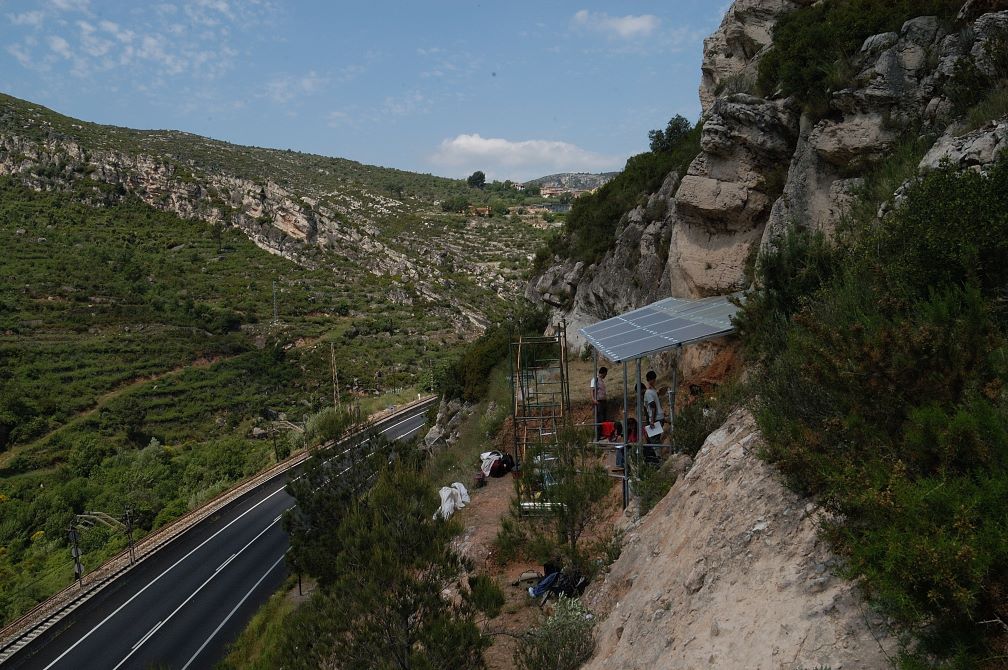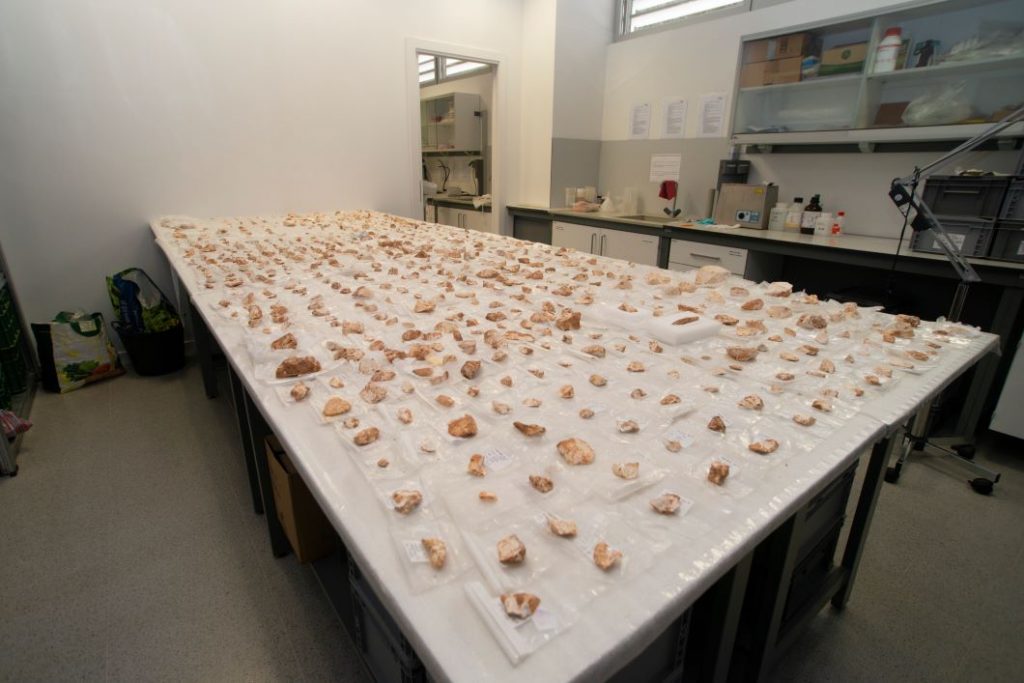08/09/2021
A current study on the Cansaladeta site confirms that it is a key place for the knowledge of the human population in the Francolí river valley 400,000 years ago
Despite currently having a small-scale excavated area, it has been possible to distinguish several moments of occupation and, within them, to identify areas of activity

Despite currently having a small-scale excavated area, it has been possible to distinguish several moments of occupation and, within them, to identify areas of activity
A study carried out by a team from the Catalan Institute of Human Paleoecology and Social Evolution (IPHES-CERCA) and the Prehistory Area of the Rovira i Virgili University (URV) on La Cansaladeta (la Riba, Alt Camp) confirms that this site is a key to know the populations of the Francolí valley 400,000 years ago. This is confirmed by the results of the first detailed techno-spatial analysis carried out on this place in La Riba. The results have just been announced with a scientific article published in the journal Archaeological and Anthropological Sciences (Springer) as part of a doctoral thesis in progress.
The methodology used for the study has allowed to document an excellent conservation of the archaeological records. This, consisting basically of stone tools, has not been negatively affected by the post-depositional processes (various phenomena with erosive potential, common in Paleolithic sites). Thus, despite currently having a small-scale excavated area (about 8 m2), it has been possible to distinguish several moments of occupation and, within them, to identify areas of activity. These results show the importance of La Cansaladeta as a key site for understanding the behaviour of the inhabitants of the Francolí river valley 400,000 years ago. At the same time, they provide consistent data to interpret the technological and subsistence variability in the Iberian Peninsula at a crucial time, the interglacial known as Marine Isotopic Stage 11 (or MIS11, ranging from 430,000 to 360,000 years before the present). This period is characterized by the appearance of human settlement in ecologically more diverse enclaves than at in previous times, and by the emergence of certain elements of a subsistence or behavioural nature (in terms of hunting strategies, in symbolic issues or, for example, in the mastery of fire) that will take us to the world of Neanderthal communities.

The study, which is available in open access, shows that the analysis of the spatial distribution of archaeological remains can provide valuable information even in small sites, if their record is very well preserved. And this is the case of La Cansaladeta site. To reach this conclusion, the stone tools of levels E and J of the site have been analyzed. With an excavated area not exceeding 8 m2, these assemblages have 1,675 and 3,166 elements respectively.
Based on the refitting study, that is, the reconstruction of flaking sequences from pieces that fit together, the spatial distribution of both these elements and the rest of the recovered materials has been analysed. This has been done by delimiting the concentrations and quantifying the density of remains using GIS (Geographic Information Systems) tools. Then, the elements of each of these accumulations have been technologically characterized (type of the raw material used, parts of the production sequence represented, typo-metrical features …), so that correspondences between the different concentrations have been recognized, and estimations of its possible contemporaneity have been made.
It should be noted that different characteristics have been observed in terms of the types of refit/conjoin connections and spatial patterns between the levels E and J. At level J, the refits document multiple retouching sequences (modification of a flake by means of small extractions, in this case, to produce a jagged edge), and multiple areas of concentration have been identified, although there is no clear evidence that they are interconnected. In addition, it is a level that has some large tools characteristic of the Acheulean assemblages, in this case produced in hornfels or schist. At level E, slightly younger, the refits enable to document basically processes of flakes production, which appear in the form of almost complete reduction sequences of flaking on an anvil of small-sized pebbles of quartz and quartzite, accompanied by simple flaking systems, with alternating platforms, on flint.

The scarcity and poor preservation of the faunal remains at both levels limits the interpretation of these occupations in some ways. However, the results obtained help us to reconstruct the dynamics of human occupations that generated the preserved record and revealed details of the behaviour and subsistence strategies of the groups that inhabited La Riba area about 400,000 years ago. From what has been found, members of those hunting and gathering societies periodically visited the Cansaladeta rock shelter and made relatively short stays there, probably taking advantage of the situation of the enclave in the middle of the La Riba strait as a checkpoint for the seasonal movements of their preys. Additionally, presence of the snapshot refit connections between the two archaeological levels is an important indicator concerning the short time activity in the site.
The research is part of the doctoral thesis that Görkem Cenk Yeşilova is carrying out at the URV and at IPHES-CERCA, under the direction of Drs. Josep Maria Vergès and Andreu Ollé, both associate lecturers at this university and researchers at this centre. His research is part of the project entitled “Paleoenvironmental evolution and prehistoric settlement in the Francolí, Gaià, Siurana and Camp de Tarragona river basins”, funded by the Department of Culture of the Generalitat de Catalunya. This refitting program is also being applied intensively to the other levels (10 in total), as one of the objectives of this thesis is to evaluate well the whole sequence of the Cansaladeta, and compare the results with those obtained in assemblages of similar chronology studied from the IPHES-CERCA, such as TD10 in the Gran Dolina site (Sierra de Atapuerca, Burgos), with an age similar to that of La Cansaladeta, or in older assemblages in the same Francolí basin , such as Cala 1 at Barranc de la Boella (La Canonja, Tarragonès), with an age close to one million years.
La Cansaladeta is located on the left bank of the Francolí river, as it passes through the Roixel·les gorge. Excavation began in 1999, under the direction of J. M. Vergès and A. Ollé. This site represents one of the oldest evidences of human presence in the Camp de Tarragona, and, in a way, shows the continuity in the territory of a human settlement that we have for the first time documented in the Barranc de la Boella, where the oldest Acheulean elements in Europe have been recorded, dated around one million years old.
Bibliographic reference (available in Open Access)
Yeşilova, G.C., Ollé, A., Vergès, J.M., 2021. Is a spatial investigation possible without long-distance refit/conjoin? Application to the MIS 11 lithic assemblage of levels E and J from La Cansaladeta site (Tarragona, Spain). Archaeological and Anthropological Sciences. https://doi.org/10.1007/s12520-021-01384-3.
